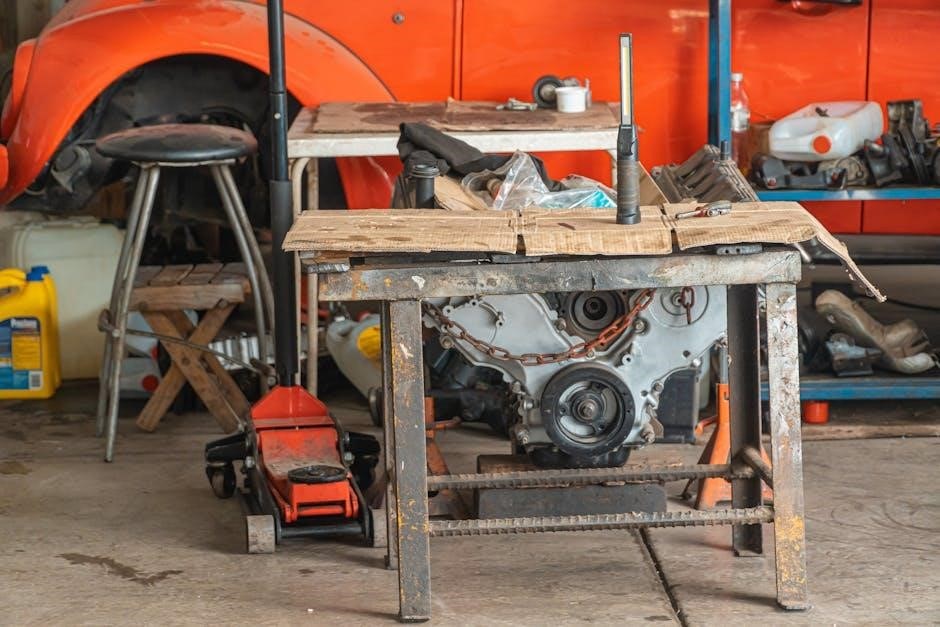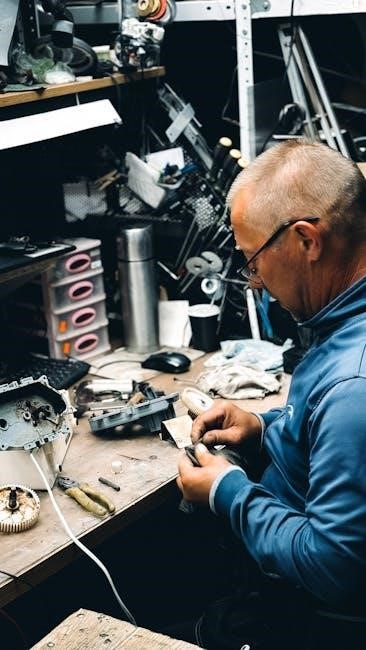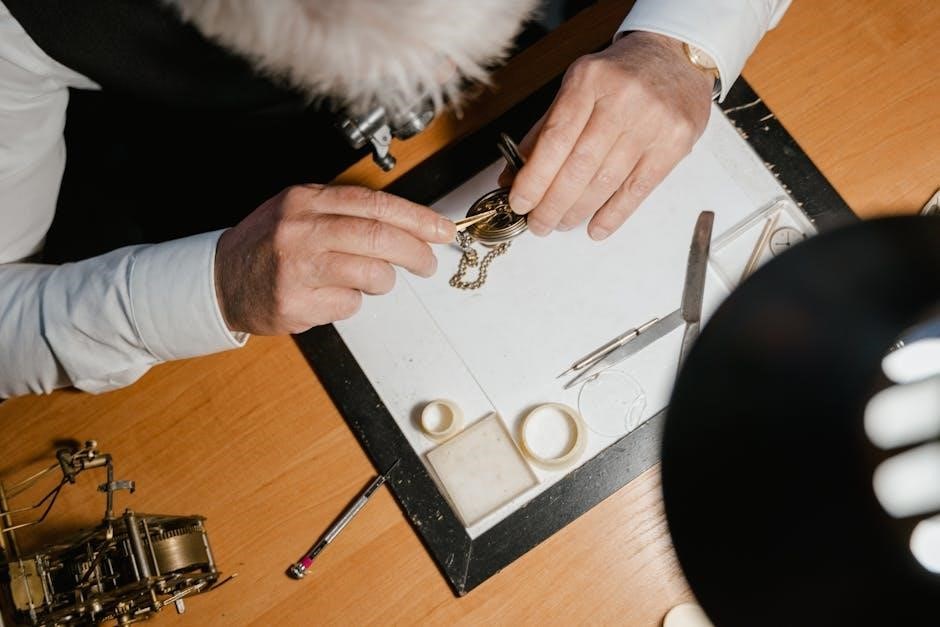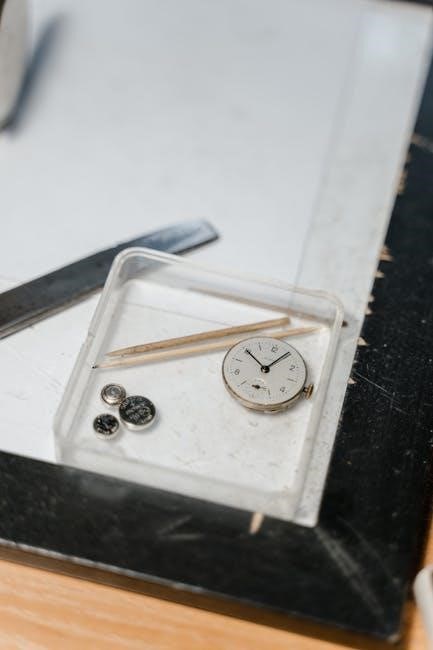The Cessna 172N Parts Manual is a comprehensive resource for maintaining and repairing the 1977-1986 Cessna 172N Skyhawk. It includes detailed procedures, parts lists, and diagrams for airframe, engine, fuel, and electrical systems, ensuring proper maintenance and compliance with safety standards.
1.1 Overview of the Cessna 172N Aircraft
The Cessna 172N is a widely used single-engine aircraft known for its reliability and efficiency. Produced from 1977 to 1986, it features a Lycoming O-320-H2AD engine, producing 160 horsepower. Popular in flight schools, the 172N is praised for its stability and ease of handling, making it an excellent trainer. Its durable design and straightforward maintenance have solidified its place as a trusted aircraft in aviation.
1.2 Importance of the Parts Manual for Maintenance and Repair
The Cessna 172N Parts Manual is essential for accurate and efficient maintenance. It provides detailed schematics, part numbers, and assembly instructions, ensuring compliance with safety standards. Technicians rely on it for identifying components, ordering replacements, and performing repairs correctly. Regular use of the manual helps prevent errors, extends aircraft lifespan, and maintains airworthiness, making it indispensable for owners and mechanics.

Structure of the Cessna 172N Parts Manual
The Cessna 172N Parts Manual is organized into sections covering airframe, engine, fuel, and electrical systems. It includes detailed diagrams, part numbers, and assembly instructions, ensuring easy navigation and reference for technicians and owners.
2.1 Organization of the Manual
The Cessna 172N Parts Manual is systematically organized into chapters and subsections for easy access. Each section focuses on specific aircraft components, such as airframe, engine, and landing gear, with detailed part numbers, diagrams, and assembly instructions. This structure allows technicians and owners to quickly locate information, ensuring efficient maintenance and repair processes. The manual is fully searchable and bookmarked for convenience.
2.2 Key Sections and Subsections
The Cessna 172N Parts Manual includes key sections like airframe components, engine specifications, fuel systems, and electrical systems. Subsections detail part numbers, diagrams, and assembly instructions. The manual also covers landing gear, navigation, and communication equipment. Appendices provide reference materials, ensuring comprehensive coverage of all aircraft parts and maintenance requirements. This structure aids technicians in efficiently locating and understanding critical information.
Airframe and Landing Gear
The airframe includes wings, fuselage, and empennage, while the landing gear features a fixed tricycle design. Components are made from durable materials like aluminum alloys for longevity and corrosion resistance.
3.1 Detailed Components of the Airframe
The airframe consists of the wings, fuselage, and empennage, with structural components like struts and ribs ensuring durability. The manual provides detailed diagrams and part numbers for each section, aiding in identification and replacement. Inspection intervals and maintenance guidelines are outlined to ensure structural integrity and safety. Aluminum alloys are primarily used for corrosion resistance and strength.
3.2 Landing Gear Assembly and Parts
The landing gear on the Cessna 172N includes main gear, nose gear, wheels, and brakes. The manual details components like axles, oleo struts, and attachment hardware. Instructions cover lubrication, tire pressure, and inspection procedures. Optional upgrades, such as larger tires, require field approval. Proper maintenance ensures safe landings and prevents wear-related issues. Regular checks are vital for durability and functionality.
Engine Specifications and Parts
The Cessna 172N is powered by the Lycoming O-320-H2AD engine, a 4-cylinder, air-cooled, direct-drive design producing 160 HP at 2700 RPM. It features dual magnetos and eight spark plugs for reliable ignition, with detailed part specifications outlined for maintenance and replacement purposes;
4.1 Lycoming O-320-H2AD Engine Overview
The Lycoming O-320-H2AD is a four-cylinder, air-cooled, horizontally opposed engine. It produces 160 horsepower at 2700 RPM, utilizing dual magnetos for reliable ignition. Equipped with a carburetor, it offers a direct-drive system, making it efficient and durable. The engine’s design ensures optimal performance, reliability, and ease of maintenance, making it a cornerstone of the Cessna 172N’s operation and longevity.
4.2 Critical Engine Components and Their Functions
The Lycoming O-320-H2AD engine features key components like cylinders, pistons, crankshaft, and camshaft, ensuring efficient power generation. Dual magnetos provide reliable ignition, while the carburetor delivers precise fuel-air mixture control. These components work harmoniously to maintain optimal engine performance, reliability, and longevity, critical for safe and efficient flight operations in the Cessna 172N.
Fuel and Electrical Systems
The Cessna 172N’s fuel system ensures efficient fuel delivery, while the electrical system provides reliable power distribution, both essential for safe and efficient aircraft operation.
5.1 Fuel System Components and Maintenance
The Cessna 172N’s fuel system includes tanks, fuel lines, pumps, and selectors. Regular maintenance involves inspecting for leaks, cleaning filters, and ensuring proper fuel flow. The manual provides detailed procedures for servicing and replacing components, emphasizing safety and efficiency to prevent fuel-related issues during flight. Adhering to these guidelines ensures optimal performance and minimizes risks.
5.2 Electrical System Wiring and Circuit Breakers
The Cessna 172N’s electrical system features wiring harnesses, circuit breakers, and avionics. The manual details troubleshooting faults, replacing circuit breakers, and inspecting wiring for damage. Proper maintenance ensures reliable power distribution to essential systems, enhancing safety and functionality during flight operations. Regular checks prevent electrical failures and guarantee optimal performance of all aircraft systems.

Navigation and Communication Equipment
The Cessna 172N features standard avionics, including VOR, localizer, glide slope, and marker beacon receivers. Communication equipment includes an intercom system and a BendixKing KY 196A com radio.
6.1 Standard Avionics in the Cessna 172N
The Cessna 172N is equipped with a range of standard avionics designed to enhance navigation and communication. These include a VOR (VHF Omnidirectional Range) receiver for precise navigation, a localizer to guide approaches, and a glide slope indicator for accurate landings. Additionally, the aircraft features a marker beacon receiver and an intercom system for clear communication between passengers and the pilot. These systems are essential for safe and efficient flight operations.
6.2 Upgrades and Modernization Options
Owners can modernize their Cessna 172N with various upgrades, such as installing advanced GPS systems like the Garmin GNS 430 or 530, which provide enhanced navigation capabilities. Additionally, upgrading to digital avionics, such as a Primary Flight Display (PFD), improves situational awareness. Other options include adding autopilot systems for reduced pilot workload and installing ADS-B Out for compliance with modern air traffic control requirements, ensuring the aircraft remains operational in evolving airspace environments.
Maintenance and Inspection Requirements
The Cessna 172N requires regular annual inspections and compliance with specific service bulletins. Scheduled maintenance tasks include engine overhauls at 2,000 hours and inspections every 10,000 hours or 20 years.
7.1 Scheduled Maintenance Tasks
The Cessna 172N requires routine maintenance including oil changes every 50 hours, tire pressure checks, and battery maintenance. Annual inspections involve detailed checks of the airframe, engine, and systems. Additionally, compliance with service bulletins and ADs ensures safety and airworthiness. Proper documentation of all tasks is crucial for maintaining compliance and extending the aircraft’s service life.
7.2 Inspection Intervals and Procedures
Regular inspections are critical for the Cessna 172N. These include pre-flight checks, 50-hour inspections, and annual inspections. Procedures involve examining the airframe, landing gear, and control surfaces. Fuel and electrical systems are checked every 100 hours. Compliance with service bulletins and ADs ensures safety. Detailed inspection intervals are outlined in the manual to maintain airworthiness and prevent potential issues.

Troubleshooting Common Issues
This section provides guidance for identifying and resolving common mechanical and system malfunctions in the Cessna 172N. It emphasizes quick and accurate troubleshooting to prevent minor issues from escalating.
8.1 Identifying and Addressing Airframe-Related Problems
The Cessna 172N parts manual details procedures for diagnosing airframe issues, such as corrosion, cracks, or loose fasteners. Regular inspections of the wings, fuselage, and control surfaces are essential. Troubleshooting involves visual checks, torque testing, and referencing the manual for repair guidelines. Addressing problems early ensures structural integrity and safety, preventing costly repairs. Compliance with maintenance schedules is critical for longevity.
8.2 Engine and System Malfunction Diagnostics
The Lycoming O-320-H2AD engine in the Cessna 172N requires thorough diagnostic checks for malfunctions. Issues like magneto failure or spark plug fouling can be identified through performance changes. The parts manual provides detailed troubleshooting steps, including compression tests and fuel system checks. Regular inspections and adherence to maintenance schedules ensure optimal engine performance and prevent costly repairs. Early detection of system failures is critical for safety and efficiency.
Compliance and Certification
Compliance with FAA regulations is essential for the Cessna 172N. Proper certification ensures all parts and maintenance meet safety standards, guaranteeing airworthiness and operational integrity.
9.1 Regulatory Requirements for Maintenance
Adhering to FAA regulations is crucial for the Cessna 172N. Maintenance must follow strict guidelines, including periodic inspections and mandatory inspections every 10,000 hours or 20 years. Proper documentation of all maintenance activities is required to ensure compliance and airworthiness. The parts manual provides detailed procedures to help technicians meet these standards effectively.
9.2 Documentation and Record-Keeping
The Cessna 172N parts manual emphasizes thorough documentation and record-keeping. It offers detailed service history templates, maintenance logs, and compliance checklists. The manual’s searchable and bookmarked format ensures easy access to records. Proper documentation is critical for tracking inspections, parts replacements, and ensuring regulatory compliance. Accurate records also help in maintaining the aircraft’s airworthiness and value over time.
Cost of Ownership and Maintenance
The Cessna 172N parts manual helps estimate costs for parts, labor, and scheduled maintenance, ensuring owners budget effectively for inspections, repairs, and upgrades to maintain safety and efficiency.
10.1 Budgeting for Parts and Labor
Budgeting for Cessna 172N maintenance involves estimating annual inspection costs, parts replacements, and labor fees. The parts manual provides pricing for components like engine parts and avionics. Labor costs vary by location, but owners can save by planning scheduled maintenance and shopping for parts in advance. Regular inspections help identify issues early, reducing unexpected expenses and ensuring long-term airworthiness.
10.2 Reducing Maintenance Costs
Owners can reduce Cessna 172N maintenance costs by adhering to scheduled inspections, utilizing parts manuals for DIY repairs, and sourcing parts from trusted suppliers. Regular cleaning and inspections prevent corrosion and wear. Investing in preventive maintenance, like replacing seals and gaskets, avoids costly repairs later. Additionally, upgrading to efficient systems can lower long-term expenses while enhancing performance and safety.

Upgrades and Modifications
Upgrades for the Cessna 172N include engine performance enhancements, avionics modernization, and aerodynamic improvements. These modifications aim to boost efficiency, safety, and overall aircraft performance for pilots.
11.1 Performance-Enhancing Modifications
Performance-enhancing modifications for the Cessna 172N include engine upgrades such as the Lycoming O-320-H2AD, which boosts horsepower to 160 HP at 2700 RPM. Additional upgrades involve aerodynamic improvements like wingtip extensions and lightweight components, reducing drag and increasing fuel efficiency. These modifications enhance climb performance and cruising speeds, making the aircraft more efficient and responsive for pilots seeking improved capabilities.
11.2 Safety and Convenience Upgrades
Safety and convenience upgrades for the Cessna 172N include installing modern avionics like GPS navigation systems and advanced communication equipment. Upgraded landing gear, such as larger tires, improves ground handling and safety. Additionally, LED lighting enhancements and ergonomic interior modifications enhance pilot comfort and visibility, ensuring a safer and more enjoyable flying experience while maintaining compliance with regulatory standards.
The Cessna 172N Parts Manual is essential for ensuring safety, efficiency, and compliance in aircraft maintenance. It provides detailed guidance for proper maintenance practices, guaranteeing optimal performance and longevity of the aircraft.
12.1 The Role of the Parts Manual in Ensuring Safety and Efficiency
The Cessna 172N Parts Manual plays a critical role in ensuring the safety and efficiency of aircraft operations. It provides detailed procedures, parts lists, and compliance guidelines, enabling technicians to perform accurate and timely maintenance. By adhering to the manual, operators can minimize risks, maintain regulatory compliance, and optimize aircraft performance, ensuring reliable and safe flight operations for years to come.
12.2 Final Thoughts on Proper Maintenance Practices
Proper maintenance practices are essential for ensuring the longevity and safety of the Cessna 172N. Regular adherence to the parts manual guarantees compliance with safety standards and manufacturer guidelines. By following detailed procedures and staying proactive, owners and technicians can prevent potential issues, optimize performance, and reduce long-term costs. Consistent, high-quality maintenance practices are key to safe and efficient aircraft operation.
